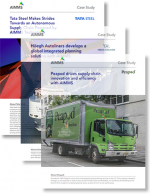Supply Chain Planning, Optimized | 3 AIMMS Case Studies
In these 3 case studies, we look at how Peapod used AIMMS based warehouse slotting optimization, how Höegh Autoliners integrated AIMMS planning solution, and how Tata Steel chose AIMMS to digitize its supply chain.
Höegh Autoliners Develops a Global Integrated Planning Solution with AIMMS
An AIMMS-based Business Planning System (BPS) was developed to replace physical (file-based) handovers between planning levels and offer a single planning database that provides relevant and up-to-date planning information to all stakeholders.
It offers an integrated solution that combines forecasted demand data, available resources, and customer and production commitments. The BPS supports the company’s planners in a controlled and cooperative manner, enabling them to evaluate different planning scenarios and react to unexpected changes in a timely way.
Results
Using a friendly user interface that facilitates collaboration across the company’s 20+ global offices, planners are able to:
- Add and remove vessels from each trade
- Add and remove ports per schedule
- Change demand forecasts
- Add and remove trades
- Restructure trades and loops
Tata Steel Makes Strides Towards an Autonomous Supply Chain Powered by AIMMS Technology
Tata Steel chose AIMMS to develop up to 11 optimization models for use across ten departments. With the output from AIMMS models, the company can improve its decision- making process and prepare to run a more automated supply chain.
They use AIMMS to optimize production capacity, understand which raw material should go to which manufacturing facility, maximize yields in different plants and streamline inbound and outbound logistics.
Results
- Lower costs
- Greater efficiency and time savings
- Better decision making
Peapod Drives Supply Chain Innovation and Efficiency with AIMMS
Peapod, an Ahold Delhaize company, considered warehouse slotting tools and planogramming software, but none of these solutions supported their unique situation: a store-like warehouse that shares inventory with shops.
What they wanted was a solution that combined the usability of out-of-the-box tools, with the ability to customize it for their needs. Districon, an AIMMS implementation partner, developed an AIMMS-based solution, called Podslotter.
Results
- 20% reduction in out-of-stock occurrences
- 6% increase in units picked from the wareroom vs. the store
- 4.5% increase in units picked from the ideal height
- New wareroom slotting time reduced from 500 to 4 hours
What’s Related




Favorites





